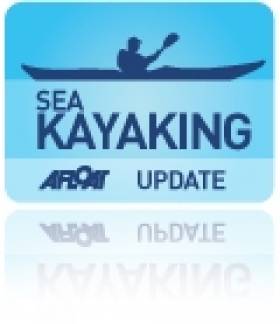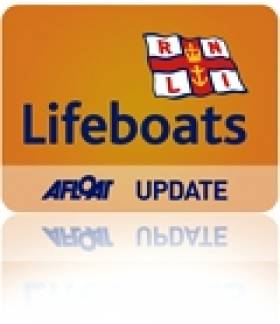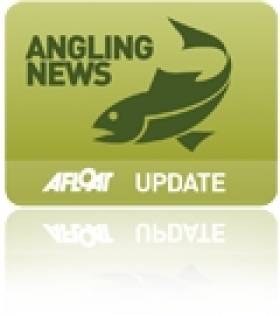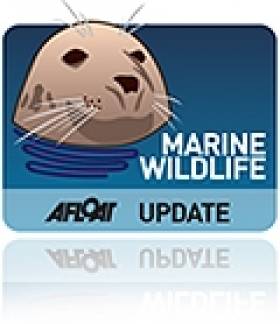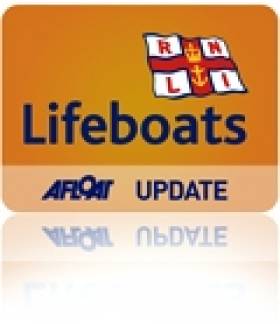Displaying items by tag: Donegal
'Unusual' Dolphin, Whale Strandings In Northwest
#MarineWildlife - Seven dolphins and two beaked whales have stranded on beaches in the northwest in events described as "unusual" by the Irish Whale and Dolphin Group (IWDG).
On the Mullet Peninsula, a group of seven common dolphins - comprising five adults and two juveniles - live stranded at Tarmon Beach on Sunday 12 May.
Though initial attempts to refloat them were successful, one of the juveniles was later found dead and the other was euthanised due to poor health.
Meanwhile in Donegal, the fresh carcass of a female True's or Sowerby's beaked whale was found on Sunday evening on Five Fingers Stand at Inishowen - some days after a reported live stranding of a Sowerby's beaked whale on the Welsh coast.
The Inishowen stranding was followed yesterday 14 May by the discovery of a dead beaked whale calf at Trawbreaga Bay, in what is believed to be a connected stranding.
Samples of the adult female were taken in order to confirm the species, either of which would mark a rare cetacean record for Ireland - the first since 2009.
'Wild Atlantic Way' Coastal Tourism Route Launched
#CoastalNotes - Minister of State for Tourism & Sport Michael Ring today (23 April) unveiled the final route for the Wild Atlantic Way, a new coastal tourism route running from Donegal to Cork.
The minister joined Fáilte Ireland to present the final route to 300 top overseas tour operators attending Meitheal 2013, Ireland’s largest tourism trade fair.
The Wild Atlantic Way will be Ireland’s first long-distance driving route, stretching from the Inishowen Peninsula in Donegal to Kinsale in Co Cork, and offering future visitors an opportunity to discover the west coast.
The 2,500km final route was unveiled following a comprehensive public consultation process and includes 156 strategically placed discovery points for tourists along the way.
While the route unveiled today comprises the main spine of the Wild Atlantic Way, a series of looped itineraries off the spine are also planned to further develop the experience for visitors.
Speaking today, Minister Ring said: “The Wild Atlantic Way is a very exciting project and I’m certain it will be a major tourism attraction. But to make it happen we all need to get on board.
"There has been a great response so far and I’m encouraging tourism operators, local authorities, business people and residents to stay involved to get this over the finishing line."
Overseas tour operators were given an advance ‘sneak-peek’ of the route last night at a Fáilte Ireland welcome event in the Convention Centre Dublin when they were treated to the premiere of the video trailer above to show them just what their clients can expect along the route from next year on.
Paddy Mathews, manager of destination development with Fáilte Ireland, believes the project will be a great addition to what Ireland has to offer visitors.
“Developing a route like this is an important part of ensuring Ireland is able to provide visitors with an unforgettable experience," he said. "It will open up a huge number of towns and attractions to them and showcase the scenery and unique culture of the West Coast of Ireland providing easy access to a range of experiences along the route.
“Now that the route has been finalised we will be focusing our efforts on turning all this preparatory work into a reality – an international driving route to rival the best in the world.”
Fáilte Ireland has been working with all the local authorities along the West Coast as well as the leader companies, Údaras na Gaeltachta and the Western Development Commission.
Full details of the Wild Atlantic Way are available on the Fáilte Ireland website HERE.
Inishowen Sea Kayak Symposium This Weekend
#SeaKayaking - The East Inishowen Sea Kayak Symposium takes place this weekend from 26-28 April.
Hosted by Just Kayak at the shorefront in Moville, Co Donegal, the weekend costs €130 for all coaching and guides, plus two nights self-catering bed and breakfast plus lunches and an evening meal.
Friday evening will feature a talk from Elaine 'Shooter' Alexander, discussing her epic circumnavigation of Ireland by sea kayak two years ago that we followed here on Afloat.ie.
Saturday will be a full day of coaching and guided trips around the Inishowen peninsula, followed by an evening of talks from guest coaches.
The final day on Sunday features a choice of different coaching sessions - and for something a little different, chef Brian McDermott will give a demonstration of outdoor cooking which might prove handy on your next kayaking trip.
For more details and booking info visit the Just Kayak website.
In other sea kayaking news, a Plymouth couple are hoping to be the first husband-and-wife team to kayak around the British and Irish coasts.
As The Herald in Plymouth reports, Andy and Jane Morton from Bere Alston left Plymouth aboard their double kayak Persey earlier this month beginning their five-month challenge for the RNLI and a local MS charity.
You can follow the couple's progress via their website HERE.
Rathmullan Marina. Yacht & Boat Berths & Storage on Lough Swilly
Rathmullan marina is a small marina pontoon at Rathmullan, a village in County Donegal is located on the western shore of Lough Swilly and is part of the Fanad Peninsula, situated roughly 12.5 miles from the Lough's entrance and 34 miles northwest of Londonderry/Derry.
The pontoon is suitable for small vessels to berth alongside at a reasonable fee and where fresh water is laid on. There is a concrete slipway suitable for dinghy landing. The Lough Swilly ferry also operates from the pier between Rathmullan and Buncrana, a journey of 45 minutes.
Station To Station Challenge Raises More Than €2,000 For RNLI
#RNLI - Two men who embarked on the first RNLI Station to Station challenge between Bundoran and Arranmore last Saturday (6 April) completed the job in just under 12 hours - raising over €2,000 for both lifeboat stations in the process.
As per their plan reported previously on Afloat.ie, Niall Clancy and James McIntyre both set off from Bundoran Lifeboat Station just after 6am on Saturday morning – Clancy running and McIntyre cycling.
Clancy's route took him through Bundoran, Ballyshannon, Donegal town, Mountcharles, Frosses, Glenties, Gweebarra Bridge, Lettermacaward, Dungloe, Burtonport and finally Arranmore Island via a treadmill on the ferry!
He was joined on various legs of the journey by members of the Tir Chonaill Athletic Club who kept his spirits up on the 100km journey from station to station.
Meanwhile, McIntyre and his team from Mullaghmore Triathlon Club and Donegal Bay Cycling Club took off at the same time cycling as far as Lough Eske, where James then made the lonesome journey himself across the Bluestack Mountains, constantly keeping organisers informed of his progress via text message.
Down into Glenties and from there by bike to Portnoo where, with Bundoran RNLI crewman Killian O’Kelly, he kayaked the remaining 22km to Arranmore Island, where both he and Clancy were greeted by the lifeboat crew and the Arranmore Pipe Band.
Speaking on completion of the challenge at Arranmore RNLI Lifeboat Station, Clancy said: "It’s been a long but great day. The weather conditions couldn’t have been any better for both myself and James – though it was very cold this morning leaving Bundoran!
"I’m looking forward to a few weeks off training before I get back into it for the Athlone Half Ironman in August."
McIntyre added: "We’d both like to express our gratitude to everyone who supported us ahead of the challenge and today – particularly those who sponsored us and those who ran and cycled with us today, our support teams, our chefs, the RNLI crews and sponsors Ormston’s Mace Ballyshannon and All Sports Donegal Town."
Shane Smith, volunteer lifeboat press officer for Bundoran RNLI, said: "We are thrilled at the success of the challenge and delighted that over €2,000 has been raised for both stations.
"We are indebted to James and Niall for their selfless support of our charity and would like to thank them sincerely on behalf of both crews."
Elsewhere, a Wexford family who organised a sponsored swim in memory of a loved one and former volunteer have raised a whopping €5,000 for Kilmore Quay RNLI.
The Hayes family presented the cheque to the RNLI at Kilmore Quay lifeboat station recently, funded by a sponsored swim on St Stephen’s Day organised by the family in memory of the late Paddy Hayes, who was a volunteer with the lifeboat.
Dramatic Donegal Rescue Marks Busy Start to 2012 for Coastguard
#Coastguard - The Irish Coast Guard has had a busy first few days of the New Year with a number of incidents around the country, including a dramatic search and rescue incident in Donegal.
Carlow man Cormac Nolan was rescued after falling 200 feet and becoming trapped in a crevasse while walking on the Slieve League cliffs on the north west coast of Donegal on Tuesday 1 January.
The cliffs are among the highest sea cliffs in Europe, and combined with the man's precarious position and the weather conditions at the time, the Sligo-based Irish Coast Guard helicopter was unable to winch the man to safety despite its swift response.
The operation - assisted by the Killybegs coastguard unit, Donegal Mountain Rescue and the Aranmore RNLI lifeboat – proceeded to a cliff descent which itself was hampered due to shingle on the cliffside.
Search teams eventually reached the casualty after 10:30pm and began the slow process of bringing him back up the cliff, finally doing so around midnight.
The 28-year-old - who discussed his ordeal on RTÉ Radio's News at One this afternoon - was transported by coastguard helicopter to Sligo General Hospital but no serious injuries were reported.
The Donegal incident was just one of a number of search and rescue taskings received by the Irish Coast Guard over the New Year period, coming after news that the coastguard saved 161 lives last year.
Other incidents included searches for missing persons in Wicklow and Dublin and dispatches to reports of persons in the water in Waterford, Limerick and Louth.
Speaking yesterday, Irish Coast Guard director Chris Reynolds said: “Last year was the busiest ever for the Irish Coast Guard and already in the early days of 2013 we have provided assistance in a number of incidents.
"I am appealing again to the public that they heed local advice and be aware of weather conditions if walking or hiking along our coastline, particularly during winter time.”
Reynolds continued: “There is safety in numbers, so never be alone while walking along cliff paths if possible. Let somebody know when and where you are going and what time you will be back. Stay well away from the cliff edge, both top and bottom. Don’t attempt to rescue people or pets if they fall over the edge.
"If assistance is required dial 112 and ask for the coastguard. Advice as always from the coastguard is if you do see someone in difficulty in the sea, on the shore, cliffs, lakes or rivers, dial 999 or 112 and ask for the coastguard.”
High Court Rules In Favour of IFI In Gweebarra Fishery Dispute
#Angling - Judgement in the first module of a High Court trial over a long-running dispute between Inland Fisheries Ireland (IFI) and local anglers at the Gweebarra fishery has been found in favour of the fisheries agency.
Ms Justice Laffoy delivered her judgement on Wednesday 19 November in the first part of a modular trial sought by IFI "to allow key issues to be determined in this first module with the objective of saving court time and costs".
The first module related to what IFI said are the most important sections of the Donegal fishery (both State and privately owned) that it manages - such as the well-known 'Mayo Pool'.
A key claim by defendants Peadar O'Baoill and others - who are opposed to changes in fishing arrangements introduced by IFI (then the Northern Regional Fisheries Board) in 2007 - was that they had acquired rights to fish freely without permits at the Gweebarra fishery by virtue of angling freely there for many years prior to the regulation changes five years ago.
IFI argued that if such rights were upheld, it would have made the 2007 arrangements "unworkable" as the rod management plan central to the changes was dependent on regulation by issue of permits.
However Ms Justice Laffoy rejected the defendants' claim in this regard, saying: “The reality is that the defendants have not established any right, public, or otherwise, to fish in the freshwater part of the Gweebarra River, including the part thereof the subject of this module.”
The court also determined conclusively that IFI has the right to manage, control and regulate both the State-owned and privately held freshwater sections of the Gweebarra fishery.
In her concluding remarks, the judge urged both parties to resolve their remaining dispute locally and out of court.
Commenting after the trial, IFI repeated its "previously stated position that it has absolutely no wish to be involved in proceedings of this nature and remains committed to the protection of the Gweebarra fishery in its entirety, the public portion of which is a state asset.
"It welcomes any initiative which will allow for sustainable management of the fishery into the future. It is happy therefore to seek to resolve the remainder of the dispute, but such would have to be found in the context of existing legal agreements with other stakeholders."
Donegal Shark Prank Not So Funny After All
#MarineWildlife - Recent hijinks by a group of Irish surfers in 'shark-infested waters' off Donegal have been making the rounds online - but they're not all what they seem.
IrishCentral reports on the video, apparently posted by surfers from Rossnowlagh, which shows the group on a RIB pushing one of their own overboard into the path of an oncoming shark.
Yet despite their reactions, they were never in any danger, as the shark was one of Ireland's harmless giants - a basking shark - who clearly attempts to dodge the dinghy as it approaches.
Indeed, the shark may even have been in more danger from the surfers than they were from it, as the marine species is designated as protected under EU law, which makes it illegal to disturb or harass them.
As reported on Afloat.ie earlier this year, the UK's Shark Trust has published a code of conduct for anyone encountering basking sharks in British or Irish waters - and pushing someone overboard on top of one is definitely absent from the list.
ESB Retiree Donates Gift Money to Bundoran RNLI
#RNLI - After 43 years working with the ESB, a Co Donegal man has donated €700 – money in lieu of retirement presents – to Bundoran RNLI.
Ballyshannon’s Brendan 'Mannix' Gallagher held his retirement party last Friday 30 November at the Allingham Arms in Bundoran but opted not for presents for himself but donations to Bundoran RNLI.
A crowd of well over 200 people attended the festivities on the night and all were delighted to make a donation to the local volunteer lifeboat service.
Brendan is well known in the area for his fundraising so it came as no surprise to the party goers that he requested donations to the RNLI.
Tony McGowan, Bundoran RNLI lifeboat operations manager, said: "We are very grateful to Brendan and his wife Joan for this thoughtful and generous method of donating to the lifeboat.
"The gesture has raised over €700 for Bundoran RNLI and will go towards the training of our volunteer crew to continue to save lives at sea."
Brendan’s retirement party is not the only local fundraiser for Bundoran RNLI at the moment. Shoppers at Sweeny Todds in Market Square Shopping Centre can purchase their Christmas cards there, and with every sale from the selected range a 50 cent donation will be made to Bundoran RNLI.
Next Sunday 16 December, the Pier Head Hotel in Mullaghmore will hold a charity wax in aid of Bundoran RNLI as part of their Christmas Family Fun Day. And the annual Bundoran Lifeboat Dinner Dance will take place at the Great Northern Hotel on Friday 1 February 2013. Tickets are on sale now from all crew members.
Bundoran RNLI also reminds the public that these are the only fundraisers at present, after reports of a 'bogus Santa' charity collector seen in Bundoran last month.
Lough Swilly RNLI Rescues Crew From Stricken Fishing Boat
#RNLI - Lough Swilly RNLI rescued five people onboard a 50ft fishing boat yesterday evening (Sunday 2 December) after the vessel’s engine broke down in Co Donegal.
During what was a nine-hour callout in tough weather conditions, Portrush RNLI also launched to assist the stricken Mary Ellen.
Volunteer crew members from Lough Swilly had been attending a commemoration in Portsalon when they were requested to launch to the boat that had broken down some 10 miles further on, a mile-and-a -half from Fannad Lighthouse.
The all-weather Tyne class lifeboat arrived on scene at 3.15pm where the crew observed a steel crabber with five men onboard. The fishing boat was carrying a load of crab.
Weather conditions at the time were described as blowing gusts of between gale force 5 and 6 up the lough.
The crew pursued to establish a towline and commence the return journey to shore. After towing the vessel for a couple of hours into the dark, the tide began to turn, making the pull more difficult. A relief lifeboat from Lough Swilly and Portrush RNLI were requested to launch to assist.
Irish Coast Guard helicopter Rescue 118 was also on scene in the event that the stricken vessel’s crew would need to be evacuated.
As the boat was being towed up the lough it lost all power and VHF was transferred from the lifeboat for communication.
When Portrush RNLI arrived on scene, the crew assisted with the tow while the Lough Swilly relief lifeboat stood by.
The stricken vessel’s mechanic managed to restart the engine during the tow and the vessel made its way into Rathmullan while the Lough Swilly lifeboat stood by in case it required further assistance.
John McCarter, Lough Swilly RNLI lifeboat operations manager, paid tribute to the lifeboat crew who arrived back at the station in the early hours of Monday morning.
"This was a long callout in difficult weather conditions and we are glad that we were able to assist this vessel and her crew in making it to shore safely,: he said.
"This was a testament of the commitment, skill and selfless nature of our volunteers who are always willing to give their time and readily leave the comfort of their homes to face challenging conditions to help people who find themselves in difficulty at sea."
Joe Joyce from the lifeboat crew told BBC News that the nine-hour operation was "an unpleasant experience" but reported that "everybody was safe and well".




























